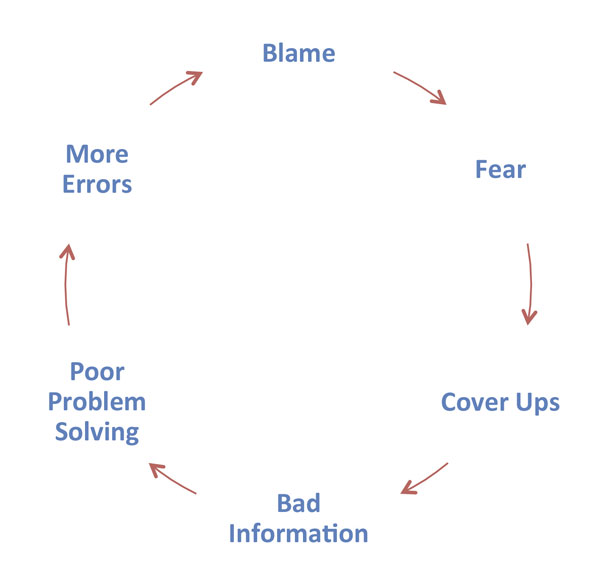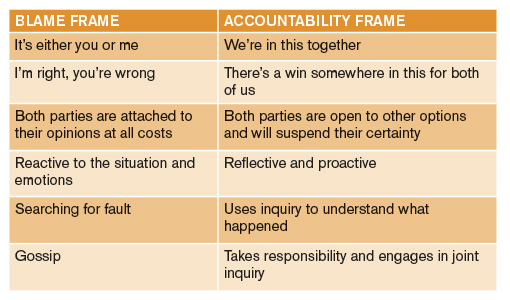The blame game is endemic in our industry. Here’s how it works: When something goes wrong, the first question that usually gets asked is, “Whose fault is it?” When the schedule slips, it’s the builder’s fault for not controlling their subs. When the budget spirals, it’s the owner’s fault for not managing scope. And when coordination issues come up in the field, it’s the architect’s fault for submitting incomplete drawings. When issues like these surface, our natural reflex seems to be to blame others, and even those of us who want to learn from our mistakes fall into naming culprits. Clearly the other guy is the problem, and changing or getting rid of him—or simply being angry at him—is the solution.
There’s a big problem with this scenario. Where there is blame, fear follows and relationships weaken. People cover up their errors and hide their concerns. And when energy goes into finger pointing, scapegoating and denying responsibility, performance suffers because the project lacks information about the real state of affairs. It’s impossible to solve problems and make good decisions with bad information. And where there’s bad information, errors increase, which leads to more blaming. It’s a vicious cycle that looks like this:

The Kaiser Permanente Santa Rosa Hospital expansion, a $150-million phased hospital campus expansion, renovation and upgrade program, is a good example of a highly complex project that could have fallen into the blame game trap but did not. At its height, more than 100 management-level people were involved, with each entity (owner, builder, designer, subcontractors and state agencies) bringing its own set of expectations and biases to the table. But in the end, the team not only produced a successful project but continues to work well together on ongoing renovation work.
Every construction team can learn from the hospital project to minimize the “blame game.” How did they do it? In my work as a consultant to this project as well as hundreds of others, here are four things they got right:
Build a Shared Direction
Every job needs to be set up for success right out of the gate, and the first way to do so is to make sure everyone shares a common set of goals. This, of course, includes assembling the right team, the right budget and the right schedule. But it also involves asking the right questions. Examples include the following:
What’s our vision for this project?
What will we be creating?
How will we be working together?
When you build a shared dream for the future, it’s easier for individuals to be comfortable with “losing the battle to win the war” when tough issues surface.
Clarify Accountabilities
One of the biggest sources of frustration on construction projects is unmet expectations. Misaligned expectations occur when people don’t understand the other’s perspective. With the number of team members and sub-specialists continuing to increase on large construction projects, the likelihood also increases that people will transition on and off and that roles will change along the way. To avoid the confusion and distrust this kind of change can create, a set of processes and procedures needs to be established upfront, along with an understanding that these very agreements will be revisited and revised on a regular basis throughout the life of the project to ensure they still make sense.
Explains Kevin Brooks, project executive with Swinerton Builders Sacramento, “In our industry, it’s generally uncommon to admit an error. And yet on every project, mistakes are always made. The key is to find ways to drive out fear regarding who is accountable for what. The first guy who makes an error on a project—and owns up to it so that we can deal with it and move on—sets the tone for the rest of the project and creates an example for others to follow.”
Create a Feedback-Rich Culture
One of the most powerful ways to create a high-performing project team is to make sure everyone is focused on continuous learning and direct, honest communication. Brooks says, “Let’s face it—giving each other feedback is hard. And in some cases, it’s not always easy to get our subs to act on the feedback we’ve given them. But the only way to deal with issues productively is to deal with each other directly, rather than sitting on something until it explodes.”
Making positive feedback a regular part of the process—and giving it equal priority to negative feedback—is crucial in creating an environment where people feel comfortable communicating with each other. It’s important to spend time reviewing what’s going well in addition to what’s not working. On the hospital project, structured vehicles were created for giving positive feedback and celebrating successes, including a light-hearted “gag awards ceremony.” This helped break down relationship barriers because it gave team members a safe way to recognize each other’s strong suits and have fun with each other’s weaknesses.
Contain the Blame
So what do you do when tough, interpersonally challenging issues arise, as they always do? It may be in the form of a misunderstanding, a lapse in communication, an unmet expectation or a failure to keep an agreement. Assume such lapses will occur, and determine upfront how and when conflict will be handled. It might be helpful to lean on a designated individual or group of individuals to help drive decisions, keep people accountable to their commitments and, if necessary, move through steps for conflict resolution. Most large, complex construction projects put in place an “escalation process” to address such issues.
On the hospital project, we determined that when large issues could not be solved locally, we would defer to a pre-established executive group. This was an important step to help diffuse problems before they became so large that they disrupted the project schedule or budget.
A preferable process, however, is for people to develop the capability to address issues as they arise, well before they have a chance to fester and take on lives of their own. This involves moving from a “blame frame” to an “accountability frame.” The following table highlights the differences between these two approaches.

To move from a blame frame to an accountability frame, here are some actions an individual can take:
- Take a break and briefly detach from the situation. Do not take action now.
- Take several deep breaths and let your emotions cool down; “self-soothe” to move out of “fight or flight.”
- Think about your long-term intentions and the results you hope to achieve with this relationship.
- Identify the cost of the conflict. Forget about who’s right and who’s wrong.
- Detach from your opinion. The first step in resolving conflicts is to find out what a winning solution would be for the “other side.”
After these steps are taken, here are some strategies people can use to move toward the accountability frame:
Frame the Conversation
- Establish that your goal is mutual understanding.
Explain Your Viewpoint
- Describe how the actions affected you without blaming the other person for your reactions.
- Describe your thoughts, desires and feelings as your truth, not the truth.
- Make it safe for the other person to express a differing or even opposing point of view as you tell your story.
Explore the Other Person’s Viewpoint
- Elicit his/her perspective on the situation.
- Do not defend or disagree.
- Demonstrate active listening.
- Validate the other person’s perspective.
- Review your respective positions.
Create New Agreements
- Affirm your mutual understanding and confirm that you are both ready to consider options.
- Brainstorm multiple options.
- If you cannot mutually agree, take time out to reconsider.
Taking a proactive approach to avoiding the blame game allows team leaders to stay focused on the end business result rather than putting their energies into conflict. Setbacks big and small are a normal part of every construction project, but how we approach them is paramount to productivity and, ultimately, business success.

